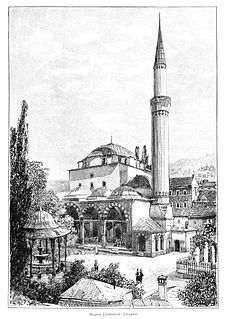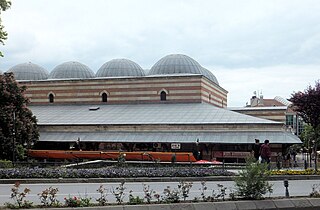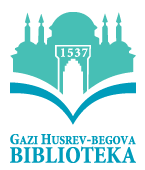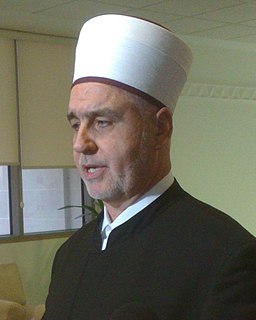This article is about the history of Sarajevo in Bosnia and Herzegovina.

Gazi Husrev-beg was an Ottoman Bosnian sanjak-bey (governor) of the Sanjak of Bosnia in 1521–1525, 1526–1534, and 1536–1541. He was known for his major contribution to the improvement of the structural development of Sarajevo urban area and his construction of many important buildings there, such as the Gazi Husrev-beg Mosque or the Kuršumlija Medresa, as well as for his successful conquests and for the launching of further Ottoman expansion into Croatia.

Gazi Husrev-beg Mosque is a mosque in the city of Sarajevo, Bosnia and Herzegovina. Built in the 16th century, it is the largest historical mosque in Bosnia and Herzegovina and one of the most representative Ottoman structures in the Balkans. Being the central Sarajevo's mosque since the days of its construction, today it also serves as the main congregational mosque of the Islamic Community of Bosnia and Herzegovina. It is located in the Baščaršija neighborhood in the Stari Grad municipality and, being one of the main architectural monuments in the town, is regularly visited by tourists.

A bedesten is a type of covered market or market hall which was historically found in the cities of the Ottoman Empire. It was typically the central building of the commercial district of an Ottoman town or city, where the most important and precious goods were kept and sold. Its function was comparable or equivalent to that of a qaysariyya in other regions, though the architecture of the latter could be different and be similar to that of a bazaar with its own streets.

Türbe is the word for "tomb" used in the Ottoman Empire. In English it especially refers to the characteristic mausoleums, often relatively small, of Ottoman royalty and Ottoman nobles and notables.

Baščaršija is Sarajevo's old bazaar and the historical and cultural center of the city. Baščaršija was built in the 15th century when Isa-Beg Ishaković founded the city.

Dr. Safvet-beg Bašagić, also known as Mirza Safvet, was a Bosnian writer who is often described by Bosniak historians as the "father of Bosnian Renaissance", and one of most renowned poets of Bosnia and Herzegovina at the turn of the 20th century. Bašagić co-founded the political journal Behar and was a founder of the cultural society and magazine Gajret, and was elected President of the Bosnian council in 1910. He is also well known for his lexicon that exceeded seven hundred biographies that he compiled over decades.

The University of Sarajevo is a public university located in Sarajevo, Bosnia and Herzegovina. It is the largest and oldest university in the country, as well as the oldest institution of tertiary learning in the former Yugoslavia, tracing its initial origins to 1537 as an Islamic madrasa.

Sanjak of Bosnia was one of the sanjaks of the Ottoman Empire established in 1463 when the lands conquered from the Bosnian Kingdom were transformed into a sanjak and Isa-Beg Isaković was appointed its first sanjakbey. In the period between 1463 and 1580 it was part of the Rumelia Eyalet. After the Bosnia Eyalet was established in 1580 the Bosnian Sanjak became its central province. Between 1864 and the Austro-Hungarian occupation of Bosnia in 1878 it was part of the Bosnia Vilayet that succeeded the Eyalet of Bosnia following administrative reforms in 1864 known as the "Vilayet Law". Although Bosnia Vilayet was officially still part of the Ottoman Empire until 1908 the Bosnian Sanjak ceased to exist in 1878.

Morića Han is a han originally built in 1551 in Sarajevo, Ottoman Empire. After a fire in 1697 it was reconstructed in its current form. Morića Han is one of the buildings which were financed by and belonged to Gazi Husrev-Beg's endowment (Vakuf). It is the only surviving han in Sarajevo. It is located in Baščaršija, Sarači street, in Stari Grad.
Ševko Omerbašić is a Croatian imam and former president of the Islamic Community in Croatia and Slovenia.
Bosnian Canadians are Canadian citizens whose ancestry can be traced to Bosnia and Herzegovina. At the 2011 Canadian census, 22,920 people stated that they are of Bosnian descent. The majority of Bosnian Canadians emigrated to Canada as refugees during and after the Bosnian War, which lasted from 1992-1995. The history of Bosnian arrivals to Canada, however, dates back to as far as the 19th century.
Murat Bey Tardić or Murad Bey Tardić was an Ottoman general.
The following is a timeline of the history of the city of Sarajevo, Bosnia and Herzegovina.

The Gazi-Husrev-beg Library is a public library in Sarajevo, Bosnia and Herzegovina founded in 1537, and is part of a larger complex with Gazi Husrev-beg Medresa. It holds one of the most important collections of Islamic manuscripts in Bosnia-Herzegovina, including many originally donated by Gazi Husrev-beg. The collection survived through Bosnian war and Siege of Sarajevo. The library also holds a sizable number of books, journals, newspapers, documents and photographs.
Firuz Bey was a 15th and 16th-century Ottoman military officer, Sanjak-bey of the Sanjak of Scutari and Sanjak of Bosnia.

Husein Kavazović is a Bosnian Islamic cleric and since September 2012 the new Grand Mufti of Bosnia and Herzegovina, after having been Mufti of Tuzla.

The Sarajevo Ramadan Festival is an annual religious and cultural festival held in Sarajevo, Bosnia and Herzegovina that celebrates the Islamic holy month of Ramadan. The festival was established in 2014 by the Sarajevo Navigator Foundation and the Zone of Improved Business (ZUP) Baščaršija in cooperation with the European Union's PHOENIX – Culture for the Future project. It is endorsed by the Oriental Institute in Sarajevo. The aim of the festival is the creation of inter-religious dialogue and the promotion of peace, reconciliation and solidarity among faith groups through the presentation of Islamic art and culture.
Husein Đozo was a Bosnian-Yugoslavian Islamic theologian and activist, Sturmbannführer of the SS and president of the Association of Ulema in the Socialist Federal Republic of Yugoslavia.

Sarači street is one of main pedestrian streets in Sarajevo, located in Baščaršija, Stari Grad Municipality. Sarači street is named after Saraç, a Turkish word for craftsmen who are making saddles.